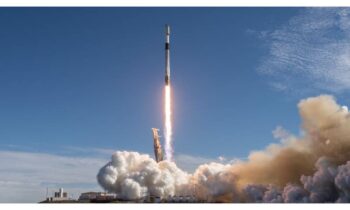
For nearly two years, China has been running its finished Tiangong orbital outpost, and it plans to add more modules and spacecraft to increase its capacity.
With the arrival of the Mengtian scientific module in November 2022, the three-module, T-shaped Tiangong space station was completed. But it appears like the station will expand once more.
Li Ming, the chairman of the China Academy of Space Technology’s (CAST) science and technology committee, stated, “In the future, we will try to upgrade our facilities,” during a plenary discussion on human spaceflight at the International Astronautical Congress in Milan, Italy, on October 17. The modules for Tiangong were created and produced by CAST.
Li said there would be several phases to the improvements to Tiangong. Updating the Tianhe core module of the Chinese space station to accommodate additional modules would be the first step.
“With this purpose, we try to upgrade the space station from the T shape. Presently it is the T shape, to the future cross shape, or you may also call it the Double-T shape,” he continued, China would be able to expand the scope of operations on Tiangong and send more racks for space science experiments and huge extravehicular missions.
“Another upgrade is developing the renewable spaceship,” Li said. Mengzhou is a multipurpose spacecraft that will be available in two versions: one for Tiangong and one for delivering crew to the moon.
“With this spaceship, we can support three astronauts for the lunar missions and also the seven astronauts for the new space station missions,” Li added.
A boilerplate test flight, which is a flight without life support or other systems, was carried out by China in 2020. It will use a low Earth orbit (LEO) version of the Long March 10 rocket, which is now under construction, and its full maiden flight is anticipated in 2027. There will also be some reuse of the new spacecraft.
Like the spacecraft, the Long March 10 will come in two versions: one for the moon and one for low Earth orbit. The new spacecraft and the Long March 10 are both essential components of China’s goal to land humans on the moon by 2030.
China’s Shenzhou spacecraft, which is larger than Russia’s Soyuz spacecraft but similar, is now used to transport its people to low Earth orbit. On October 30, the next Shenzhou mission to Tiangong is expected to depart.
The last update will significantly advance international astronomy initiatives.
“The last one [upgrade] is a CSST, Chinese Space Station Telescope, which has really large optical cameras, featuring both a large field of view and high image qualities,” Li stated. “It is also open for international communities, especially on data analysis.”
The CSST, a Hubble-class space telescope that will orbit alongside Tiangong, is also known as Xuntian. It will have the capability of docking with the space station for upkeep, repairs, and even improvements.
The bus-sized Xuntian will have a primary mirror that is somewhat smaller than Hubble’s, measuring two meters (6.6 feet) in diameter. However, it will be able to perform wide surveys because its field of view will be around 300 times greater. During its anticipated 10-year lifespan, Xuntian’s 2.5-billion-pixel camera will scan and image almost 40% of the heavens.
According to Li, China wants to increase foreign collaboration on Tiangong, including crew members and scientific activities.
“Now we are ready to welcome international astronauts to join the Chinese space station program, based on the principle of mutual respect, mutual benefit, inclusiveness and equality,” Li stated.
Tiangong is about 20% as large as the International Space Station, and China wants to keep it manned and functional for at least ten years. Therefore, when the ISS nears the conclusion of its lengthy existence in 2030 or so, Tiangong might be the only space station still in orbit.



